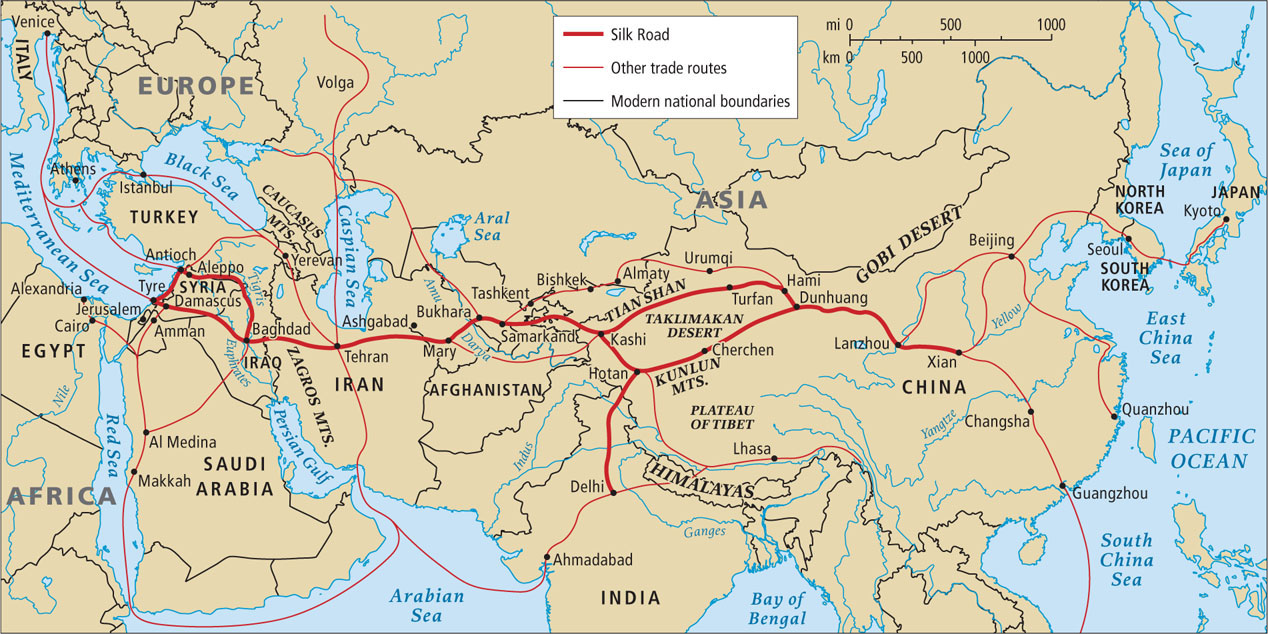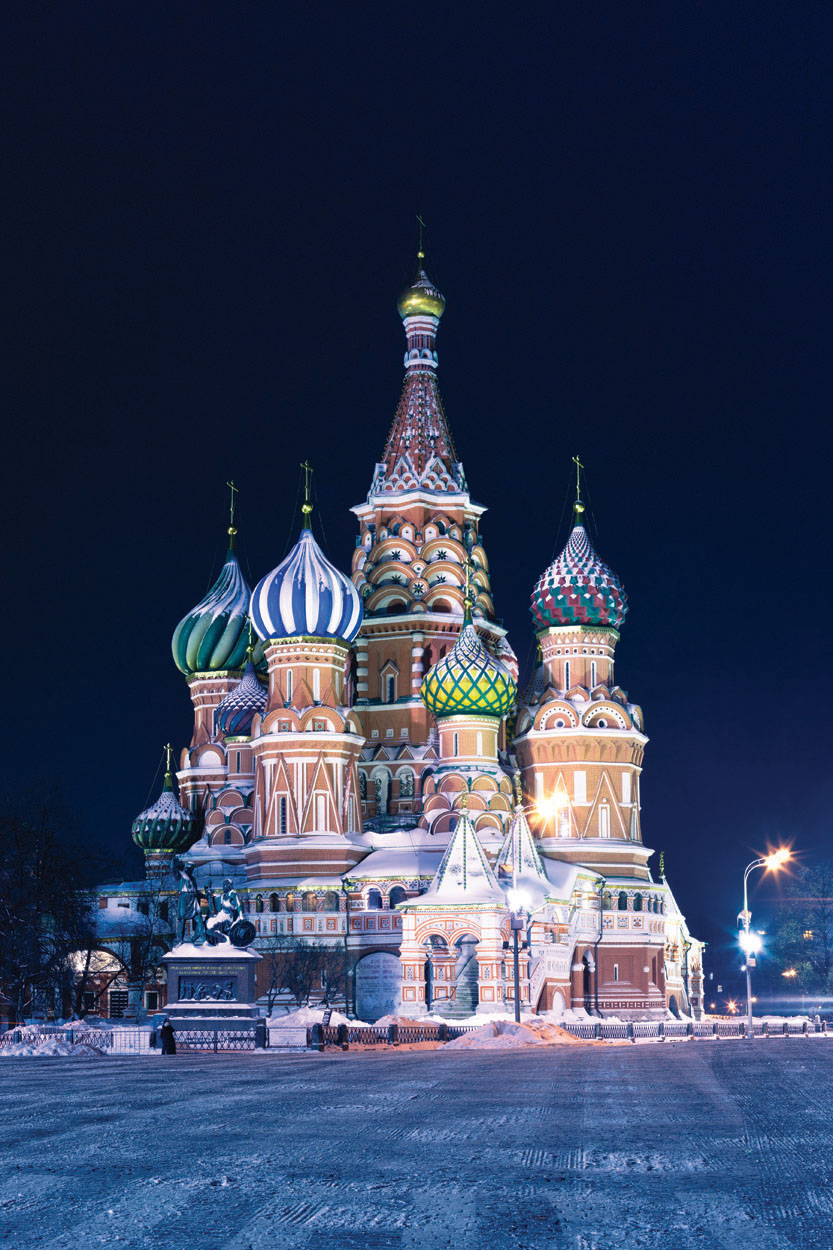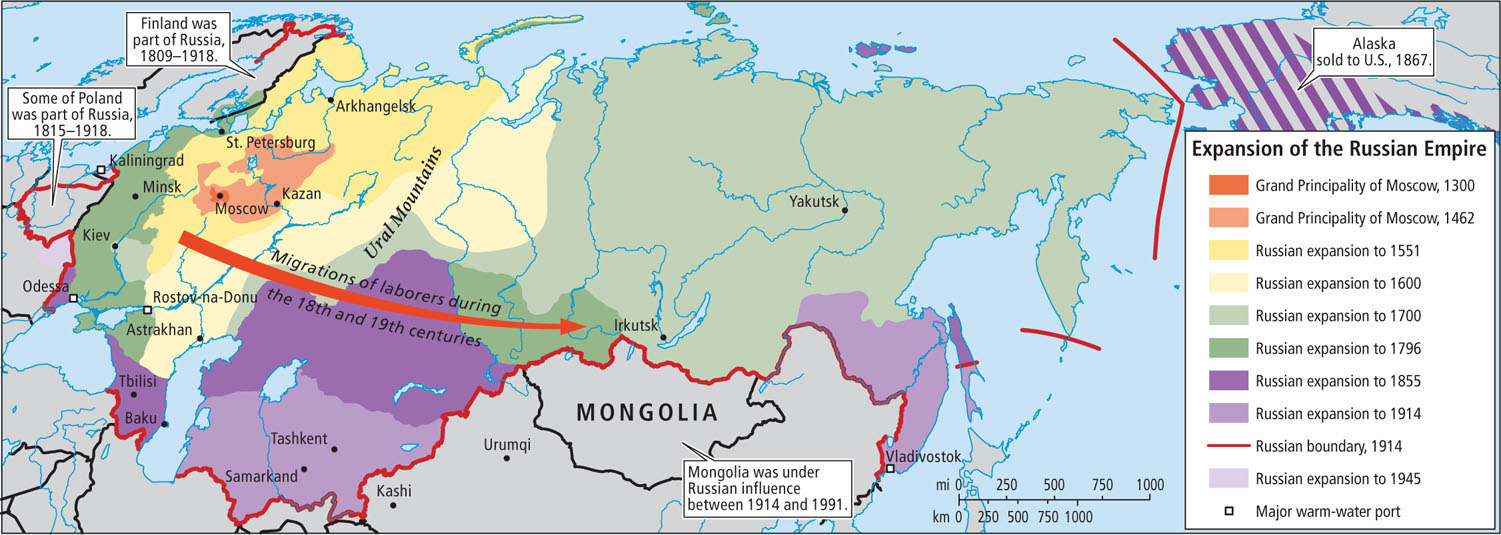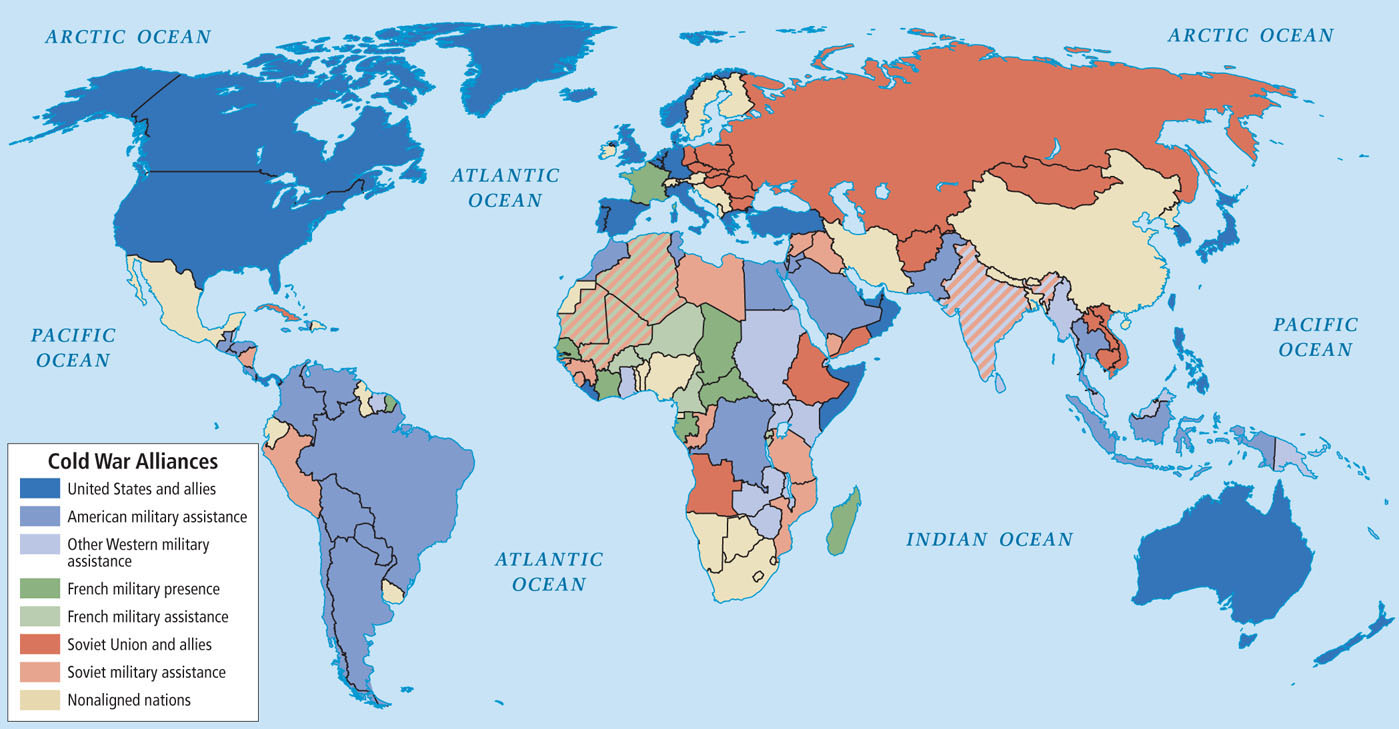Human Patterns over Time
The core of the entire region has long been European Russia, the large and densely populated homeland of the ethnic Russians. Expanding gradually from this center, the Russians conquered a large area inhabited by a variety of other ethnic groups. These conquered territories remained under Russian control as part of the Soviet Union (1917–1991), which attempted to create an integrated social and economic unit out of the disparate territories. The breakup of the Soviet Union has diminished Russian domination throughout this region, though Russia’s influence is still considerable.
The Rise of the Russian Empire
nomadic pastoralists people whose way of life and economy are centered on tending grazing animals that are moved seasonally to gain access to the best pasture
Towns arose in two main areas: the dry lands of greater Central Asia and the forests of Caucasia, Ukraine, and Russia. As early as 5000 years ago, Central Asia had settled communities that were supported by irrigated croplands (see Figure 5.10A). These communities were enriched by their central location for trade along what became known as the Silk Road, that vast, ancient, interwoven ribbon of major and minor trading routes between China and the Mediterranean with lesser connections to other places (Figure 5.9). Many commodities were traded along the route, but the eastern tradition of silk fabric became highly valued in the west, which is why the term Silk Road was applied by later historians.

Slavs a group of people who originated between the Dnieper and Vistula Rivers in modern-day Poland, Ukraine, and Belarus

Thinking Geographically
After you have read about the human history of Russia and the post-Soviet states, you will be able to answer the following questions:
Question
 In addition to trade along the Silk Road, what supported Central Asian cities?
In addition to trade along the Silk Road, what supported Central Asian cities?
| A. |
| B. |
| C. |
| D. |
Question
 From where was Orthodox Christianity introduced into this region?
From where was Orthodox Christianity introduced into this region?
| A. |
| B. |
| C. |
| D. |
Question
 How does this painting convey the poverty of the Burlaks?
How does this painting convey the poverty of the Burlaks?
| A. |
| B. |
| C. |
| D. |
Question
 How many Soviets were killed during World War II?
How many Soviets were killed during World War II?
| A. |
| B. |
| C. |
| D. |
Mongols a loose confederation of nomadic pastoral people centered in East and Central Asia, who by the thirteenth century had established by conquest an empire that stretched from Europe to the Pacific

By 1600, Russians centered in Moscow had conquered many former Mongol territories, integrating them into the growing empire and extending it to the east as shown in Figure 5.12. The first major non-Russian area to be annexed was western Siberia (1598–1689). Russian expansion into Siberia (and even into North America, along its Pacific coast) resembled the spread of European colonial powers throughout Asia and the Americas. Russian colonists took land and resources from the Siberian populations and treated the people of those cultures as inferiors. Moreover, migrations of laborers from Russia to Siberia meant that indigenous Siberians were vastly outnumbered by the eighteenth century. By the mid-nineteenth century, Russia had also expanded its control to the south in order to gain control of Central Asia’s cotton crop, its major export, used in Russian industry.

czar title of the ruler of the Russian empire
The Communist Revolution and Its Aftermath
Periodic rebellions against the czars and elite classes took place over the centuries. By the mid-nineteenth century, these rebellions were being led not only by serfs, but also by members of the tiny educated and urban middle class. In 1917, at the height of Russian suffering during World War I, Czar Nicholas II was overthrown in a revolution. What followed was a civil war between rival factions with different ideas about how the revolution should proceed. Eventually the revolution brought a complete restructuring of the Russian economy and society, according to what at first promised to be a more egalitarian model—a model that was extended to adjacent countries.
Bolsheviks a faction of Communists who came to power during the Russian Revolution
communism an ideology, based largely on the writings of the German revolutionary Karl Marx, that calls on workers to unite to overthrow capitalists and establish an egalitarian society where workers share what they produce
capitalists usually a wealthy minority that owns the majority of factories, farms, businesses, and other means of production
Communist Party the political organization that ruled the USSR from 1917 to 1991; other communist countries, such as China, Mongolia, North Korea, and Cuba, also have ruling Communist parties
The Stalin Era
centrally planned, or socialist, economy an economic system in which the state owns all land and means of production, while government officials direct all economic activity, including the locating of factories, residences, and transportation infrastructure
The centerpiece of Stalin’s vision was massive government investment in gigantic development projects, such as factories, dams, and chemical plants, some of which are still the largest of their kind in the world. To increase agricultural production, he forced farmers to join large government-run collectives.
Stalin’s strategy of government control met many of his expectations. It brought rapid economic development and higher standards of living. Schools were provided for previously uneducated poor and rural children, and contributed to major technological and social advances. During the Great Depression of the 1930s, the Soviet Union’s industrial productivity grew steadily even while the economies of other countries stagnated, allowing for the development of a large military.
However, Stalin’s economic development model also had deep flaws. With production geared largely toward heavy industry (the manufacture of machines, transportation equipment, military vehicles, and armaments), less attention was paid to the demand for consumer goods and services that could have further improved living standards. Ultimately, communism also proved to be less innovative than capitalism and unable to develop advanced technologies to sustain economic growth over time.
The most destructive aspect of Stalin’s rule, however, was his ruthless use of the secret police and mass executions to silence anyone who opposed him. Those who resisted were forced to work in prison labor camps, the so-called gulags, many of which were located in Siberia. Here prisoners mined for minerals and also built and worked in newly constructed industrial cities. Millions were executed or died from overwork under harsh conditions. Estimates vary greatly, but between 20 and 60 million people were killed as a result of Stalin’s policies.
World War II and the Cold War
Cold War the contest that pitted the United States and western Europe, espousing free market capitalism and democracy, against the USSR and its allies, who were promoting a centrally planned economy and a socialist state

A wide variety of economic and political problems led to the eventual collapse of the Soviet Union. Fundamental flaws with Soviet central planning led to innumerable inefficiencies and chronic mismanagement. Many problems also were related to the diversion of scarce resources to the military, including the Soviet space program, and away from much-needed economic and social development (see Figure 5.10F). Soviet efforts to promote communism in less developed countries were also expensive, as was extensive political, economic, and military coercion in Central Europe and Central Asia. As problems multiplied, so did resistance to Soviet control, especially in Central Europe in the late 1980s. Because the last Soviet leader, Mikhail Gorbachev, did not resort to violence to control the countries of Central Europe, they were able to abandon communism and instead establish democracy. Eventually, this dissension spread to the republics that made up the Soviet Union itself, and by 1991, the USSR had formally dissolved.
A war in Afghanistan also helped to stretch the USSR past the breaking point (see Figure 5.17A). In the 1970s in Afghanistan, which lies just to the south of the Central Asian states, there was contention among a small group who favored a Western-style democratic government, those who favored communism, and Muslims who favored a theocratic state based on Islamic law. The Soviets feared that the strongly anti-communist Muslim movement in Afghanistan would influence nearby Central Asian Soviet republics to unite under Islam and rebel against the USSR. In response, the USSR backed an unpopular communist government that allowed Soviet military bases in Afghanistan. This brought strong resistance from the Muslim fundamentalist Mujahedeen movement, and in 1979, Russia launched a war to support the Afghan government. A bloody, decade-long conflict ensued, concluding with the Soviets being defeated by Afghan guerillas who were financed, armed, and trained by the United States. This is an example of the geopolitical struggles that took place during the Cold War. Within 2 years of the Soviet withdrawal from Afghanistan, the USSR disintegrated. The Soviet–Afghan conflict and the aftermath are discussed further in Chapter 8.
THINGS TO REMEMBER
 As early as 5000 years ago, Central Asia had settled communities that were supported by irrigated croplands and enriched by trade along what became known as the Silk Road.
As early as 5000 years ago, Central Asia had settled communities that were supported by irrigated croplands and enriched by trade along what became known as the Silk Road. The Bolsheviks, a group inspired by the principles of communism, were the dominant leaders of the Russian Revolution of 1917. Their goal, never achieved, was an egalitarian society where people would work out of a commitment to the common good, sharing whatever they produced.
The Bolsheviks, a group inspired by the principles of communism, were the dominant leaders of the Russian Revolution of 1917. Their goal, never achieved, was an egalitarian society where people would work out of a commitment to the common good, sharing whatever they produced. Taking control in 1922, Joseph Stalin brought to the country a mixture of brutality and revolutionary change that set the course for the rest of the Soviet Union’s history. He established a centrally planned, or socialist, economy in which the state owned all property and means of production, while government officials in Moscow directed all economic activity. This system became known as a command economy.
Taking control in 1922, Joseph Stalin brought to the country a mixture of brutality and revolutionary change that set the course for the rest of the Soviet Union’s history. He established a centrally planned, or socialist, economy in which the state owned all property and means of production, while government officials in Moscow directed all economic activity. This system became known as a command economy. After World War II, a nearly 50-year-long global geopolitical rivalry known as the Cold War pitted the Soviet Union and its allies against the United States and its allies.
After World War II, a nearly 50-year-long global geopolitical rivalry known as the Cold War pitted the Soviet Union and its allies against the United States and its allies.